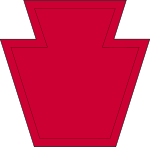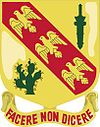2-107th Cavalry Regiment
| 2nd Squadron 107th Cavalry Regiment | |
|---|---|

28th Infantry Division shoulder sleeve insignia
|
|
| Active | 1887-present |
| Country | United States |
| Branch | United States Army |
| Type | Cavalry |
| Role | Recon and assault |
| Size | Battalion |
| Part of | 2nd Brigade, 28th Infantry Division, Ohio Army National Guard |
| Garrison/HQ | Cincinnati, Ohio |
| Motto(s) | Facere Non Dicere (To Act, Not To Speak) |
| Engagements |
World War I
World War II
Kosovo Iraq |
| Decorations |
Meritorious Unit Commendation (3) |
| Commanders | |
| Current commander |
LTC Josh Quantz |
| Insignia | |
| 107th Cavalry distinctive unit insignia |  |
World War I
World War II
Kosovo
Meritorious Unit Commendation (3)
Presidential Unit Citation
Philippine Presidential Unit Citation
The 2nd Squadron, 107th Cavalry Regiment is a cavalry squadron of the 2nd Brigade 28th Infantry Division and the Ohio National Guard located throughout southwest Ohio.
The 107th Cavalry was formed in 1877 in Cleveland as a local militia following the great railroad strike. On 10 October 1877 the Troop was named the First City Troop of Cleveland. On 10 September 1887 the unit was mustered into the Ohio National Guard. On 12 September 1895 by command of the Governor the organization dropped the name of The First City Troop of Cleveland and became known as Troop A, Ohio National Guard.
During this time Webb C. Hayes, the son of Rutherford B. Hayes, the 19th President of the United States, served as Quartermaster Sergeant in the Troop. Webb C. Hayes later received a Regular Army commission retiring as a full colonel. Colonel Hayes served during the Spanish–American War, the Philippine Insurrection, the Boxer Rebellion and World War I. For service during the Philippine Insurrection, he received the Congressional Medal of Honor.
Shortly after the sinking of the Maine, Troop A was designated as the nucleus of a regiment of eight troops, and called the First Ohio Volunteer Cavalry. The City of Cleveland with the aid of Troop A raised an additional two troops of cavalry (Troops B & C). Other troops were Troop D from Columbus, Troop E from Toledo, Troop F from Dayton, Troop G from Marysville and Troop H from Cincinnati. The First Ohio Volunteer Cavalry Regiment was organized into two squadrons and mustered into federal service, 9 May 1898. Captain Matthias W. Day, USA, was commissioned Lieutenant Colonel of Volunteers and assigned command of the regiment. The regiment assembled for action in Puerto Rico but a shortage of sea transports delayed their sailing and the war ended.
On 10 June 1899 Troop A was called out to perform strike duty. After this duty, Troop A returned to its previous activities of parades and military maneuvers. In 1908, "The Tobacco War" between Ohio and Kentucky began. On 7 May, Troop A was ordered to Ripley Ohio to protect the Ohio farmers. Troop B, an unattached cavalry troop from Columbus, reinforced Troop A. The troop was relieved of duty on 21 May and returned to Cleveland. In 1910, a streetcar strike occurred in Columbus, which caused Troop A to be called to duty, on 8 July. On 25 July 1910 by Special order 148, the Adjutant General of Ohio authorized the formation of the First Ohio Cavalry Squadron including Troop A in Cleveland, Troop B in Columbus, Troop C in Cincinnati and Troop D in Toledo. Command of the First Cavalry Squadron from its organization to its Mexican Border duty in 1916 passed from Major W. C. Scofield to Major Otto Miller and finally to Major D. J. Hurd. After 1910 Troop A returned to its former activities of parades and military encampments.
...
Wikipedia
